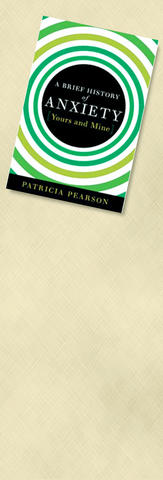For a brief but intense period in 2006, Patricia Pearson logged on daily to Flu Wiki. This is a Web site (fluwikie.com) devoted to the concerns - the very deep concerns - of people convinced that a worldwide outbreak of influenza is imminent, and that it will make the ravages of the Black Death seem like a mildly unpleasant interlude.
"Here could be found a great milling together of fiercely articulate and freaked-out people from around the world, posting to discussion topics like 'What Will We Do With the Bodies?' Pearson writes in A Brief History of Anxiety. Visitors to the site offered suggestions on how to turn back the infected, zombie-like hordes who, in a desperate search for food, will try to invade the fortified homes of the healthy.
Pearson, the author of the highly amusing Area Woman Blows Gasket, sees the humor in Flu Wiki, but she too worries about pandemics. A lot. She also obsesses about sudden liver failure, possibly cancerous moles, flying insects, the supervolcano underneath Yosemite National Park and the possibility that her car will blow up. All of this seems potentially hilarious, but the humor quickly freezes as Pearson describes a lifetime of absurd but crippling fears.

Like 40 million Americans, Pearson suffers from anxiety, which she pithily calls "fear in search of a cause." Her own case fascinates her, and quite rightly. It presents her with the opportunity to examine modern civilization and its discontents, as well as her own miseries, which she does, thoughtfully and incisively.
Her subject is elusive. Unnamed until Freud coined the term "anxiety neurosis," the uninvited stranger lurks at the margins of history. When King David, in the Bible, says that "fearfulness and trembling are come upon me," is he suffering an anxiety attack? Pearson cites an 18th-century English treatise blaming city living for "a class and set of distempers, with atrocious and frightful symptoms, scarce known to our Ancestors," that is, "nervous disorders" afflicting a third of the population. Could this be it?
Everywhere and nowhere, anxiety, Pearson writes, is "unbearably vivid yet insanely abstract." In many cases it is the fear of fear itself, a free-floating, nebulous entity that, like a mutant virus, feeds on any available host. Reason is powerless against it. Pearson argues, in fact, that rationalism, intended to banish superstition and fear, has instead removed one of the most effective weapons against anxiety, namely religious faith and ritual.
Even worse, the worship of reason and science, by encouraging the notion that human beings can control their environment, has created a terrible fault line in the modern psyche, although not all societies suffer equally. Mexicans have lots to worry about but don't. The World Mental Health Survey, conducted in 2002, found that only 6.6 percent of Mexicans had ever experienced a major episode of anxiety or depression. Meanwhile, to their north, 28.8 percent of the American population has been afflicted with anxiety, the highest level in the world. Mexicans who move to the US adapt, becoming more anxious.
In searching for the roots of her affliction, Pearson finds a common thread connecting her traumas and her phobias, the fear of losing control, of being unable to cope. As a child, caught up in the India-Pakistan war in 1971, she cowered in her family's house in New Delhi, waiting for bombs to fall. She was terrified of the dark. At 23, she suffered a nervous breakdown after her boyfriend casually informed her, on a visit to her family's summer house in Canada, that he was seeing another woman. A diagnosis of "generalized anxiety disorder" ensued.
Pearson never finds satisfactory answers to her self-interro-
gations, but the professionals do not do much better. The angriest pages in her book are devoted to the psychiatrists who put her on a regimen of anti-anxiety medications, which dulled the static in her brain but left her "in an emotional half-light," secure but disengaged.
"I'd watch movies without being stirred by them, listen to music without real interest," she writes. "In truth, I began to feel faintly sociopathic." She became addicted to Effexor, and late in the book drops the small bombshell that, as she writes, she has been off an antidepressant called Lexapro for only six weeks.
Pearson married and had children. She has a successful writing career. But the woman she describes can barely hold her life together. One night she dreams that she is lying on a cushioned bench admiring the Grand Canyon. Suddenly she realizes that the bench is attached at one end to a cliff face but is otherwise suspended in midair.
"If I moved even an inch in any direction, I would fall for miles," she writes. "The choking panic that I felt was extraordinary. I felt a perfect - a Platonic - sense of terror."
That, in a nutshell, is her situation, one that she addresses through therapy, pull-up-your-socks willpower and a blend of religion and the insights of writers like the cultural geographer Yi-Fu Tuan. It all seems touch and go - but give her major points for wit and flair. The author biography on the dust jacket reads: "She lives in Toronto with her husband, her two children and her dread."

On the final approach to Lanshan Workstation (嵐山工作站), logging trains crossed one last gully over a dramatic double bridge, taking the left line to enter the locomotive shed or the right line to continue straight through, heading deeper into the Central Mountains. Today, hikers have to scramble down a steep slope into this gully and pass underneath the rails, still hanging eerily in the air even after the bridge’s supports collapsed long ago. It is the final — but not the most dangerous — challenge of a tough two-day hike in. Back when logging was still underway, it was a quick,

From censoring “poisonous books” to banning “poisonous languages,” the Chinese Nationalist Party (KMT) tried hard to stamp out anything that might conflict with its agenda during its almost 40 years of martial law. To mark 228 Peace Memorial Day, which commemorates the anti-government uprising in 1947, which was violently suppressed, I visited two exhibitions detailing censorship in Taiwan: “Silenced Pages” (禁書時代) at the National 228 Memorial Museum and “Mandarin Monopoly?!” (請說國語) at the National Human Rights Museum. In both cases, the authorities framed their targets as “evils that would threaten social mores, national stability and their anti-communist cause, justifying their actions

In the run-up to World War II, Admiral Wilhelm Canaris, head of Abwehr, Nazi Germany’s military intelligence service, began to fear that Hitler would launch a war Germany could not win. Deeply disappointed by the sell-out of the Munich Agreement in 1938, Canaris conducted several clandestine operations that were aimed at getting the UK to wake up, invest in defense and actively support the nations Hitler planned to invade. For example, the “Dutch war scare” of January 1939 saw fake intelligence leaked to the British that suggested that Germany was planning to invade the Netherlands in February and acquire airfields

Taiwanese chip-making giant Taiwan Semiconductor Manufacturing Co (TSMC) plans to invest a whopping US$100 billion in the US, after US President Donald Trump threatened to slap tariffs on overseas-made chips. TSMC is the world’s biggest maker of the critical technology that has become the lifeblood of the global economy. This week’s announcement takes the total amount TSMC has pledged to invest in the US to US$165 billion, which the company says is the “largest single foreign direct investment in US history.” It follows Trump’s accusations that Taiwan stole the US chip industry and his threats to impose tariffs of up to 100 percent